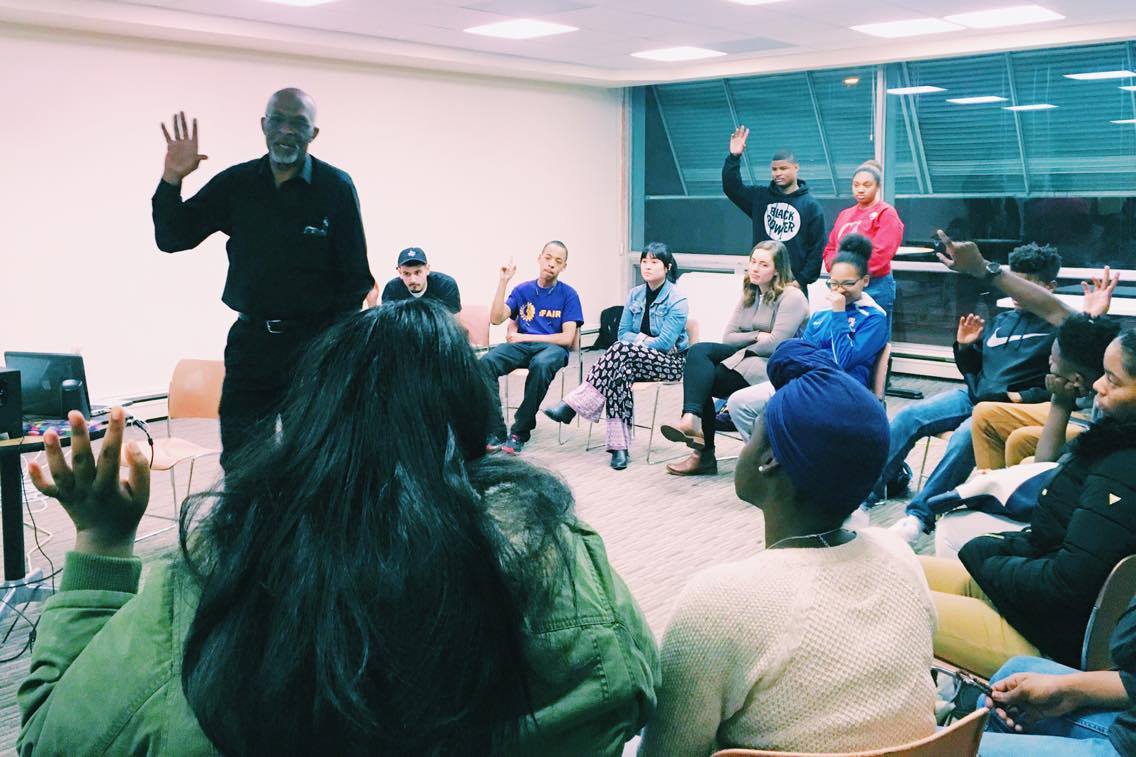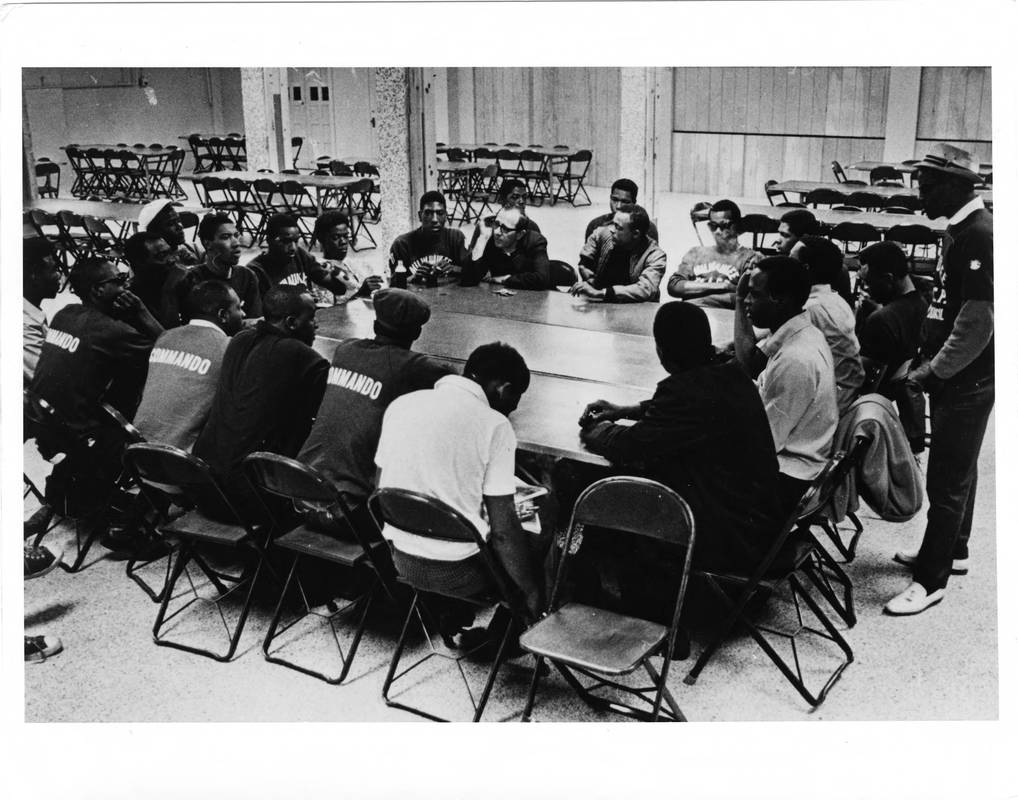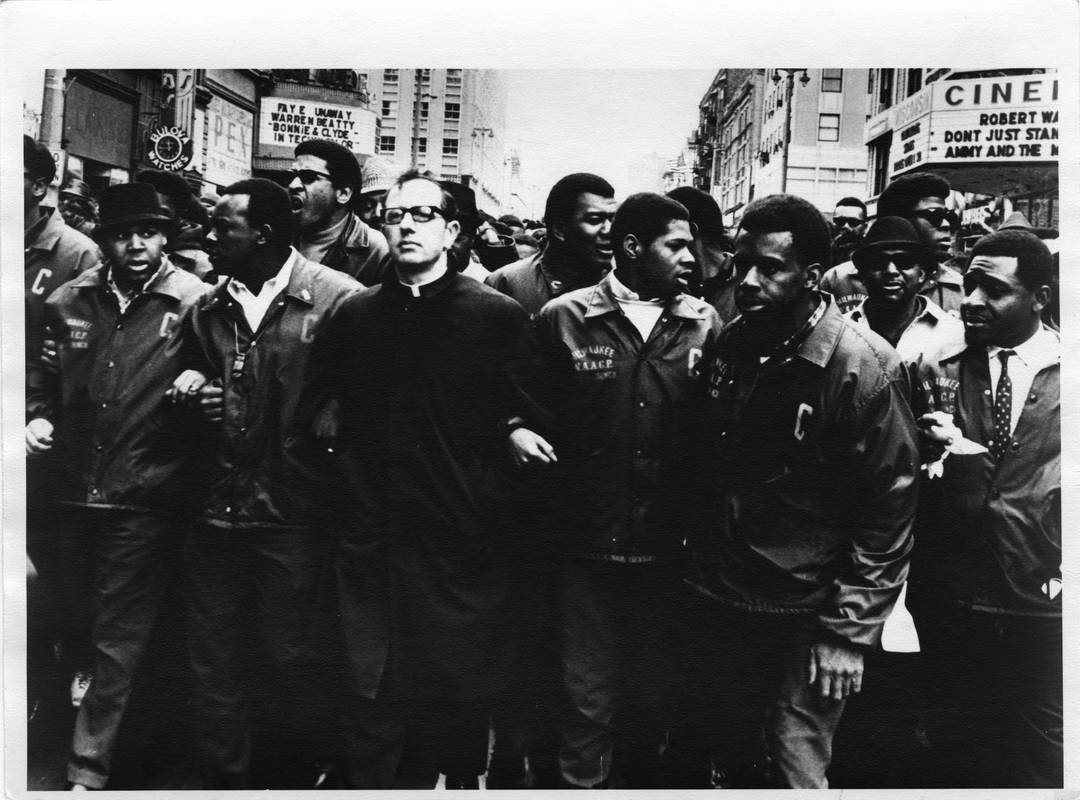|
I experienced the significance and importance of the Fair Housing Marches in a very real way tonight, surrounded by teenagers I love and in the presence of a living legend. Glancing back and forth between the enthralled faces of my students and the enraged but encouraging face of Prentice McKinney very clearly illustrated why these stories need to be told 50 years later. McKinney is one of the original Commandos who played a major leadership role in orchestrating the Fair Housing Marches in Milwaukee in 1967, usually with a cigarette in hand. The commandos were a militant but peaceful group of young black men who lead demonstrations and protected the marchers and spokespeople as part of Milwaukee's NAACP Youth Council.
McKinney didn't seem too excited to talk to me personally, but his face lit up when he began to speak to the young leaders in the room, pacing back and forth with his arms moving with every word. He told stories of the racism he experienced as a young person, the anger he felt, the kind of life he wanted his mother to be able to have, and the hopes he had for future generations to have a better quality of life than he did. McKinney sought to embolden the students in the room to take his torch and become the next generation of youth activists in Milwaukee. He spoke passionately about his fight and how Milwaukee used to be the most segregated city in the country. Then, one of the students spoke up and said, "It still is." McKinney nodded solemnly in knowing agreement. Though not surprising, it was so powerful to be in that room and hear about McKinney's struggle 50 years ago while also listening to a 16-year-old boy describe how he feels like a "second class citizen" in his own city in 2017. The students could be McKinney's grandchildren, and they are who he marched for. I'm telling you about this encounter because it flooded my mind with ideas we could do for our capstone project on the anniversary of the marches. Though it would be a difficult undertaking to quantify, I think it would be so fascinating to present data in a way to show if the quality of life has been improving by generation. From both empirical data and personal stories, we could compare life in Milwaukee for people of color in 1967 to 2017. Though there have been a plethora of studies done to show that there is severe racial disparity and inequality in Milwaukee, I think it would be incredibly interesting and impactful to present it in the frame of: this is what our elders fought for 50 years ago; this is is what their life was like here, and this is what it's like for black youth now. Though it may be frustrating for all involved, I think it is important to know what has changed and what hasn't, what's gotten better, and what's gotten worse. Some factors I think would be essential to look into are changes in housing policy, prominence of housing discrimination, economic investment/disinvestment by neighborhood, income inequality and income mobility. I recognize that the big question in this situation is: why is Milwaukee still the most segregated city in the country 50 years later, but I am having doubts that we would be able to tackle that in an effective way over the course of a couple months. I think that all factors of oppression are intersectional, and I am afraid of oversimplifying a complex historical issue. However, it would be worth pursuing this ambition, and I look forward to learning if any of my classmates have ideas on how we could approach a question as daunting as that. Ultimately, I think our data visualization could serve as an educational tool to community members, but especially to our youth. I think it is so important to contextualize the way things are in this city, and by displaying data over the course of generations, I think young people would have a better idea of why their lives are shaped the way they are and could feel more empowered to follow in the footsteps of those who came before, the courageous leaders like McKinney. We have so much to learn from our elders for the sake of our youth.
1 Comment
Despite any shady "look" that Professor Lowe may or not throw at students when they walk into a classroom too close to the time that the class is intended to start, I felt nothing but good vibes as I took my seat among a rockstar group of students for our first day of our journalism capstone course.
Looking around at familiar faces and other faces that I have heard nothing but good things about, I felt optimistic about what we would be able to accomplish together over the course of the next few months. When we learned a little more about what the semester would consist of, the positive energy in the room only seemed to increase. I was thrilled to hear that we would be taking it upon ourselves, with the help of an online course, to become better at using data to tell stories in a visual and/or interactive way. No matter how each of us plans to use storytelling going forward in our lives, data visualization will only continue to play a more and more important role. The potential subject of our work was also greeted with a warm welcome. The 50th Anniversary of the Fair Housing Marches in Milwaukee is a historic landmark that is deserving of every ounce of attention it receives over the next year or so. I am fascinated by the stories of the marches and the way that housing policy has shaped this city I call home and am excited to work to make information about the significance of these events more accessible and interesting to the average Milwaukeean. Also, Fr. James Groppi is one of my absolute all time heroes, so any excuse I have to learn more about him is an always appreciated opportunity. (And yes, Professor Lowe, it will also be cool to win a trophy.) In order to embrace this challenge and to hold ourselves and each other accountable to the kind of growth we would like to see and high quality pieces we are expecting to produce in this capstone, we took an honest look at our perceived strengths and weaknesses during the first class period and discussed them with each other. Strengths:
Weaknesses:
I can't wait to see the ways that we improve and the awesome projects we will create. |
AUTHORI am a senior studying journalism and international affairs at Marquette University. I am a Milwaukee-dweller and a storyteller passionate about exploring the intersection between community-building and communication. I'd love for you to learn alongside me! ARCHIVES
March 2017
|



